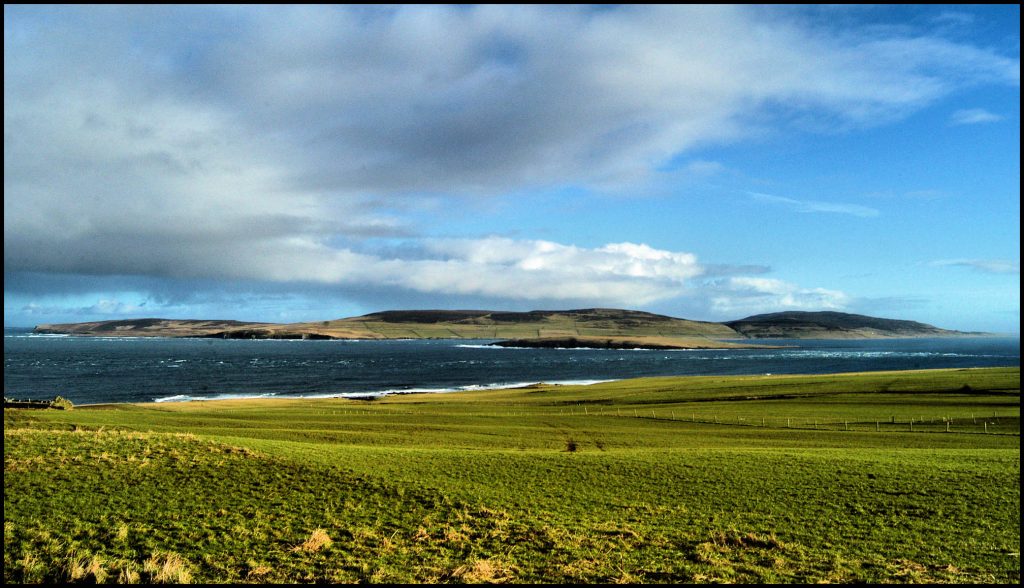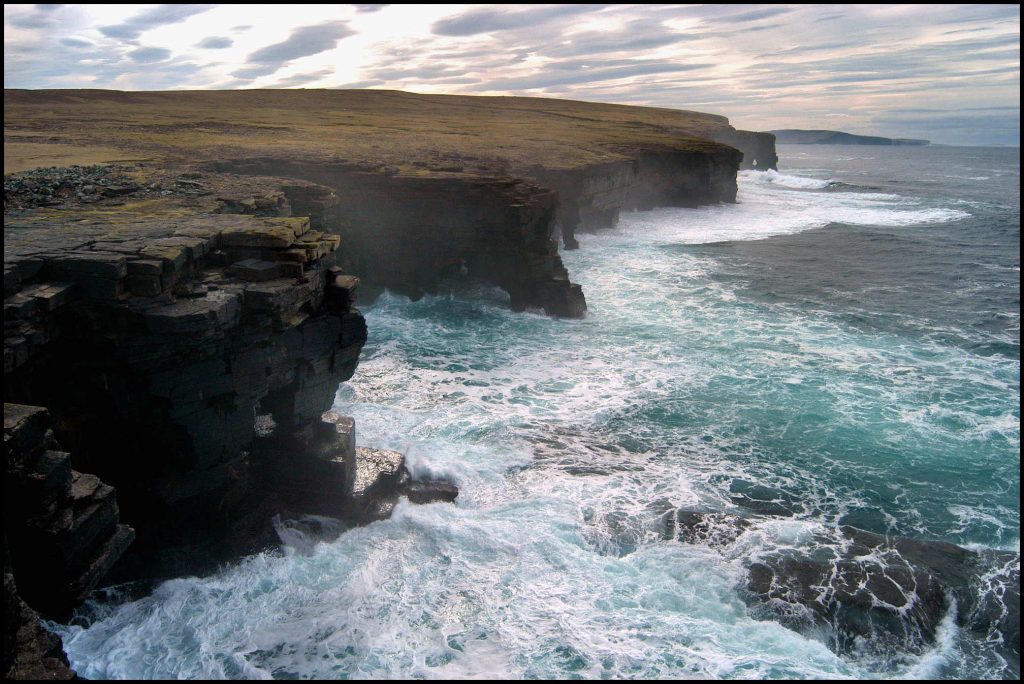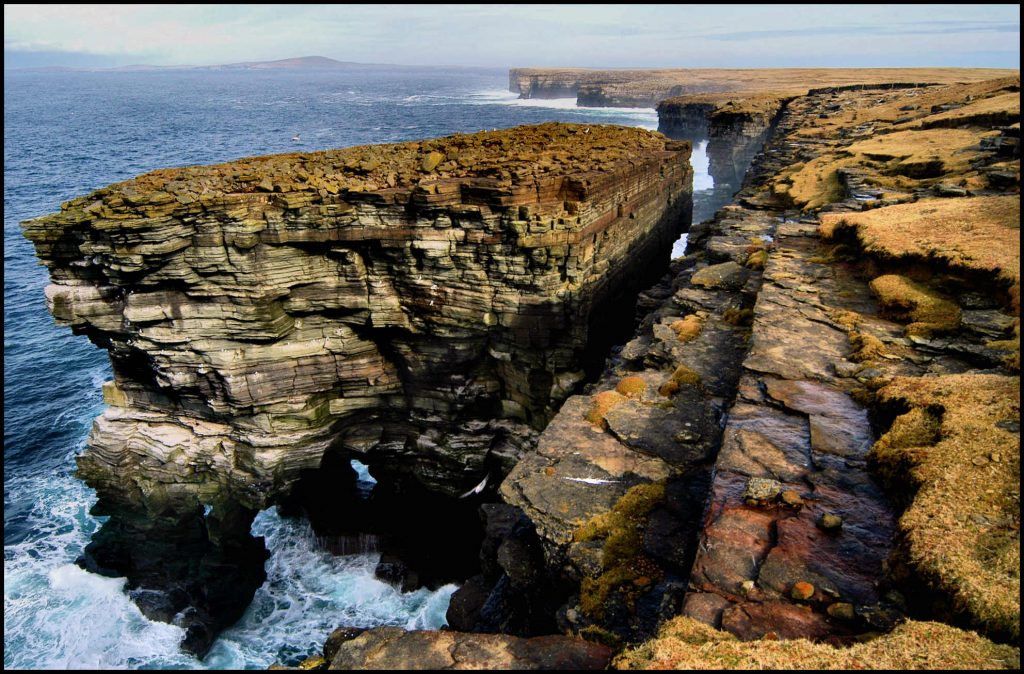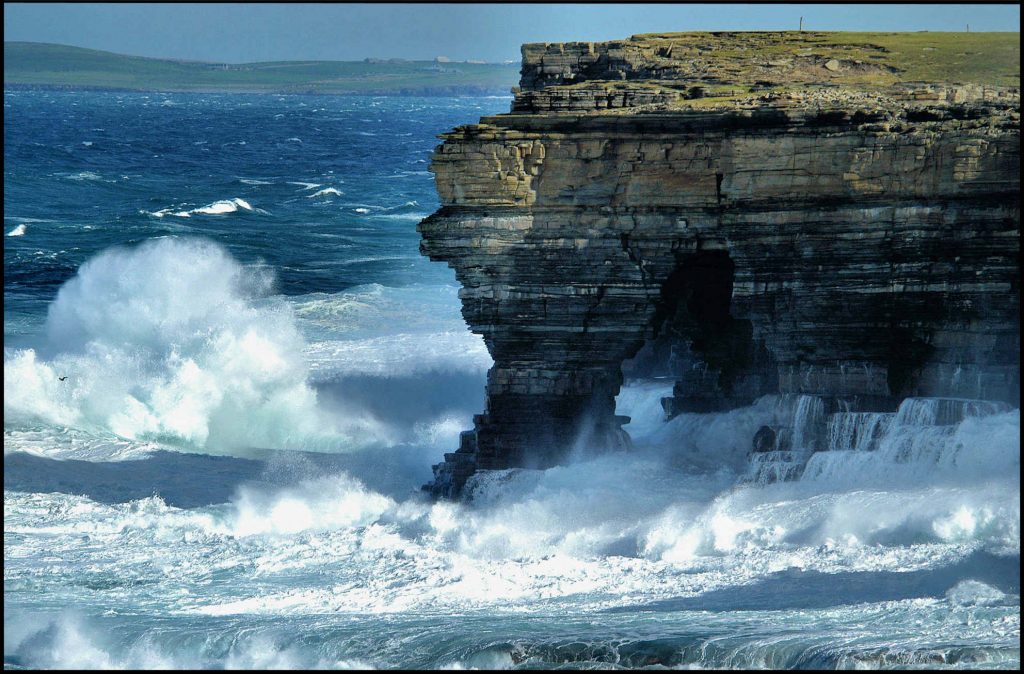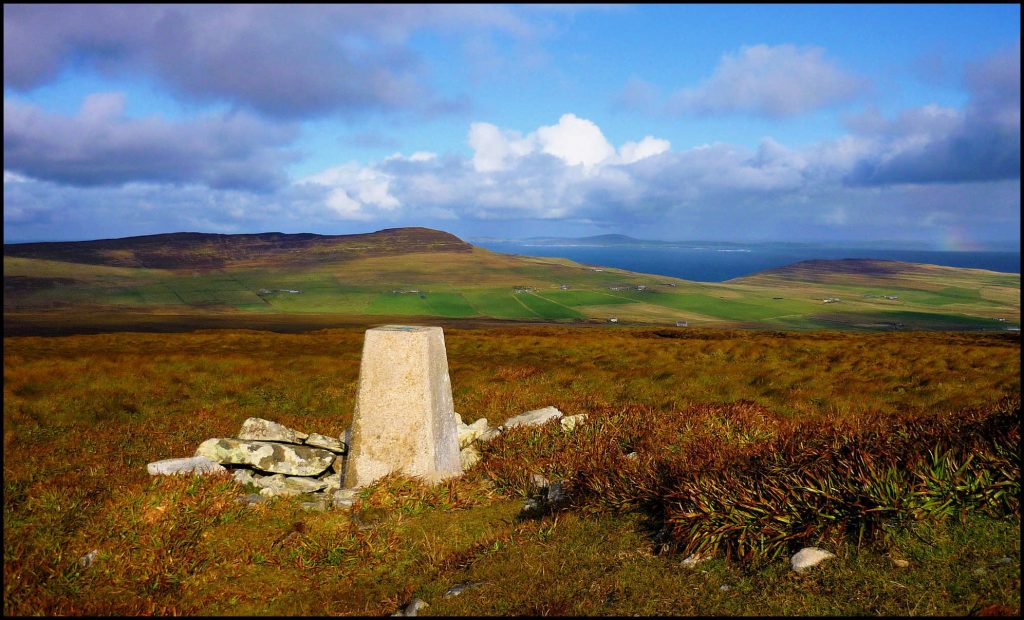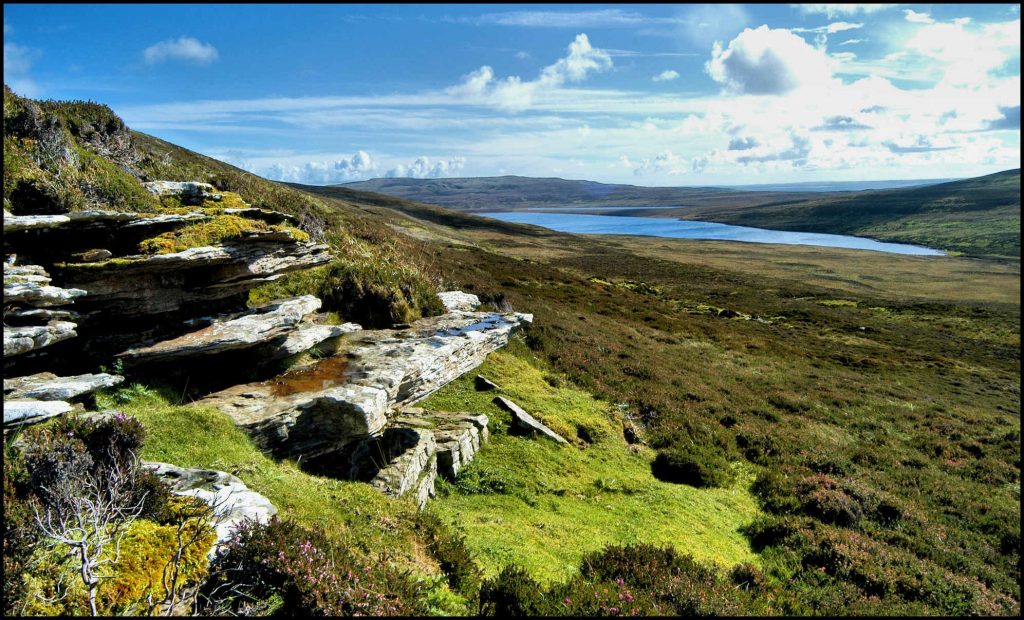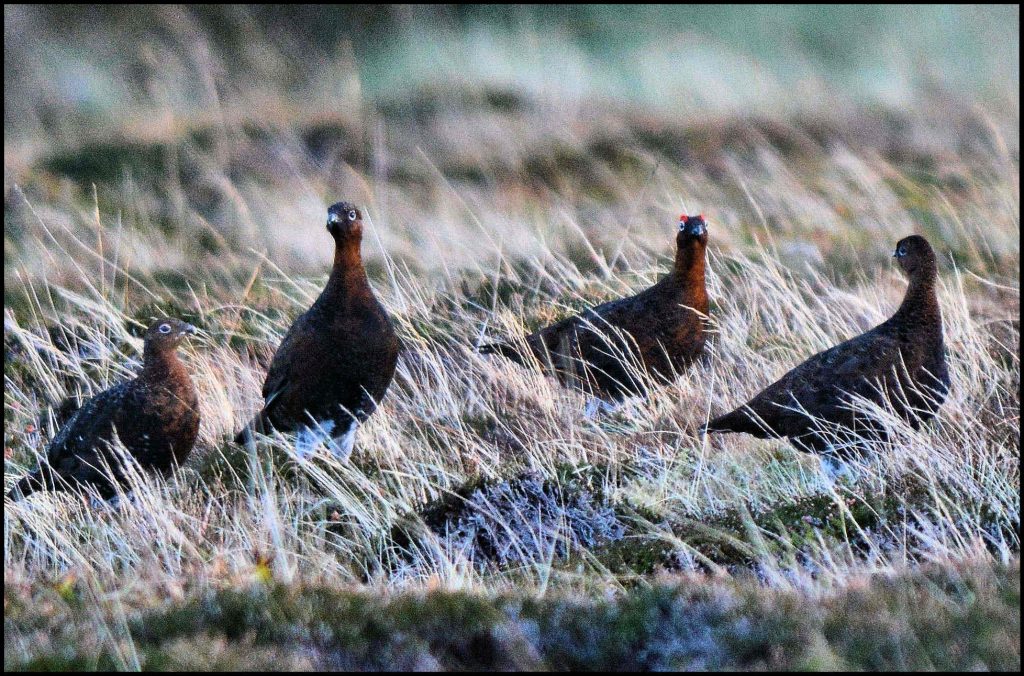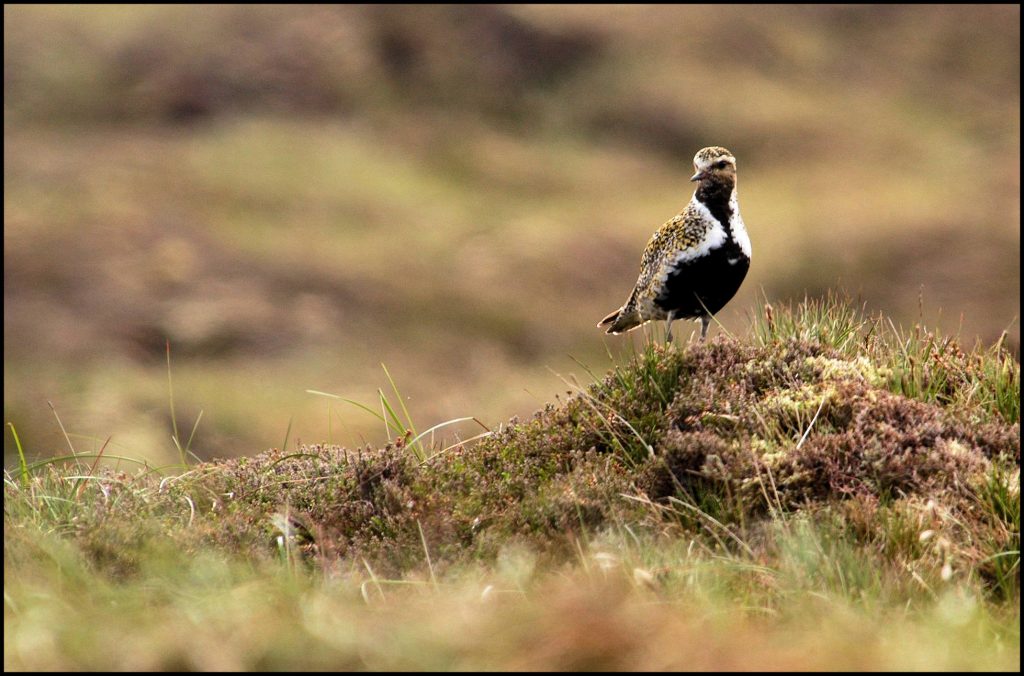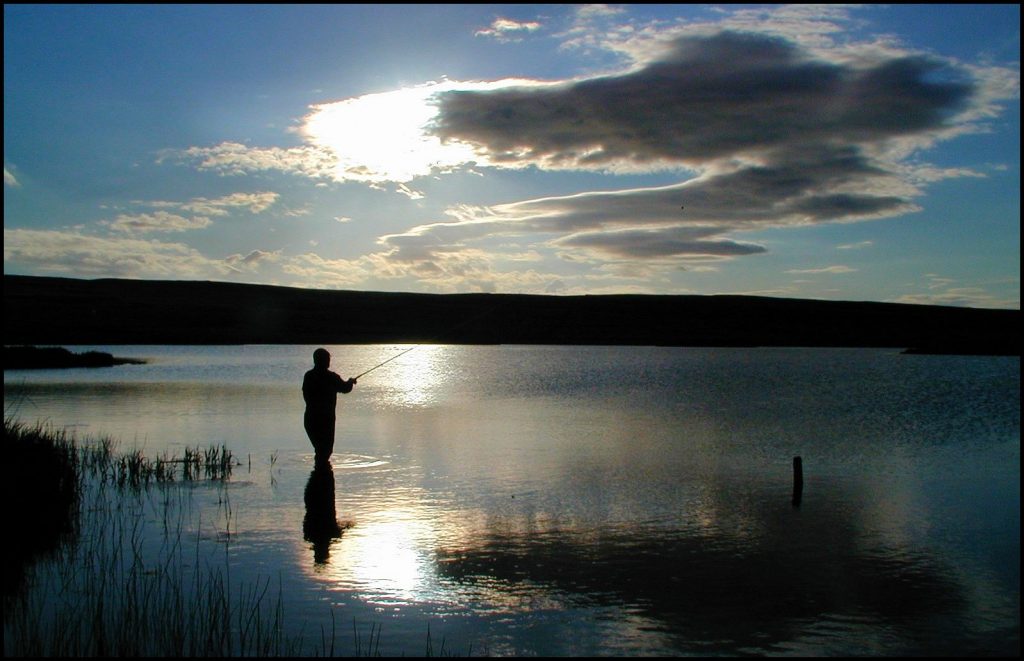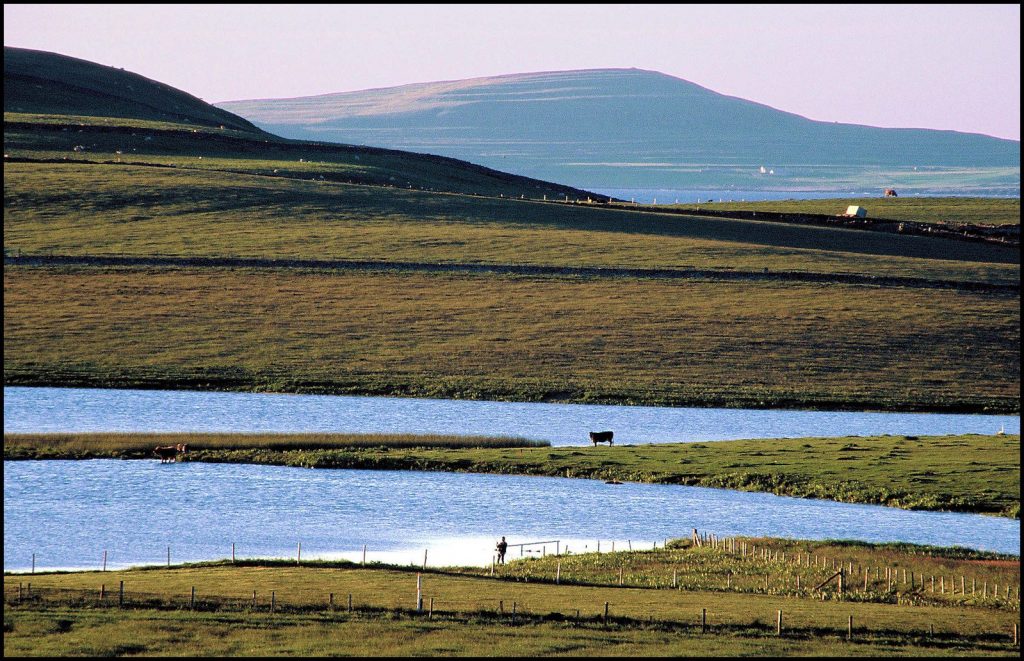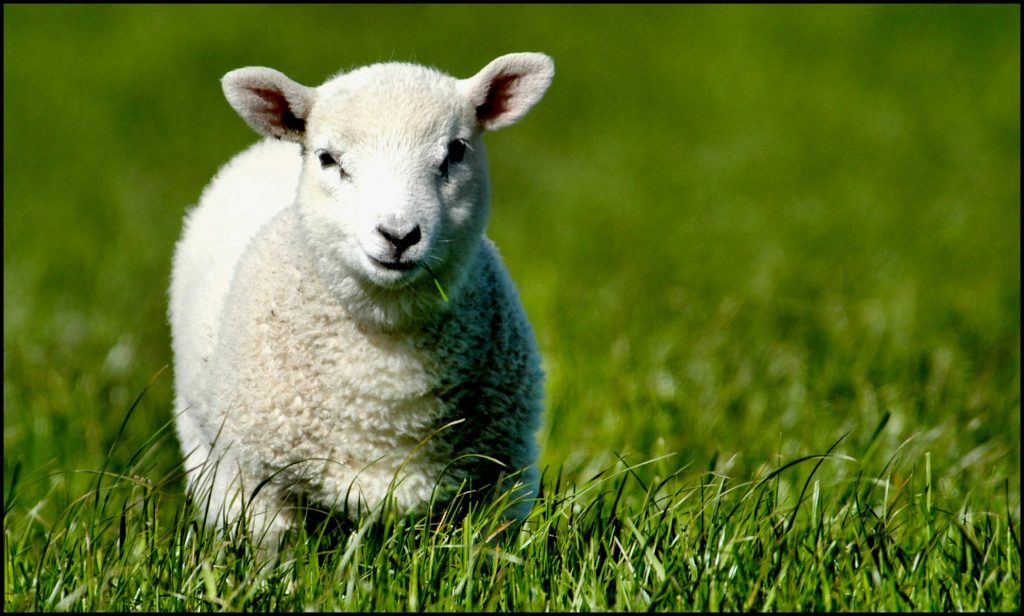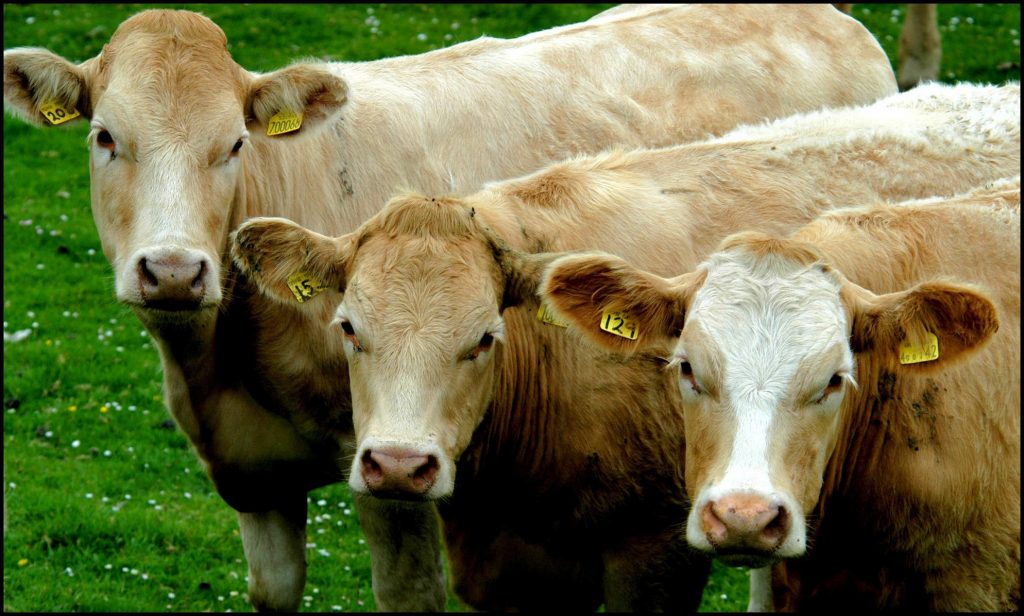A Description of Rousay and Viera
from
The Orkney Herald
19 June 1889
In Thursday’s Rod and Gun, Rousay and Viera form the subject of the eleventh article of the series on “The Sporting Estates of Scotland.” The article is illustrated by views of Trumland House and the more striking features of the coastline. The following extracts may be of interest: –
[There were in fact no images in this particular version of the article – so I have added my own!]
The estates of Rousay and Viera consist of three islands in the well-known Orkney group, off the northern coast of Scotland, from which they are separated by the Pentland Firth. Rousay is an island of considerable size, and is separated from Viera, which is much smaller, by a channel about a half-a-mile broad. All three islands are exceedingly fertile. The whole of Viera is cultivated land, and all round the coast of Rousay there is a broad strip of the finest arable and pastoral land in the extreme north of Scotland. The centre of the island of Rousay is chiefly moorland and rough pasture, and yields large bags of grouse and other Highland game, while over the whole of the other portions of the estate there is excellent low-ground shooting. There are several first-rate trout lochs in which sea-trout are got; and salmon might easily be introduced into one of the lochs. The sea fishing round the coasts may fairly be said to be unrivalled in Scotland, and there is a small salt-water loch at Rousay that offers exceptionally good facilities for oyster culture. There are two mansion houses, one of them quite new, fitted with all modern conveniences, and containing accommodation for a large establishment, and the other well adapted for a lodge with a separate shooting. Valuable minerals are to be found on the larger island; but they have not yet been worked. The climate throughout the year is remarkably equable; and the whole estate is in first-rate order, great improvements having been quite recently effected in farm buildings, cottages, roads, fencing, drainage, &c. Both of the islands are in the county of Orkney and Shetland, and form part of the united parish of Rousay and Egilsay.
The Orkneys embrace altogether fifty-six islands at high water, and about thirty of these are inhabited. They cover an area of about 610 square miles, and have a coastline exceeding 570 miles. This group of islands, as seen from the higher grounds of Rousay, presents a beautiful panorama as they repose on the blue waters of the North Sea. There is a wonderful variety in the forms they assume, and the irregularity of outline and shore is very picturesque. Some of the islands lie low in the water, and others, chiefly facing the Atlantic Ocean, dash off white sparkling foam from their bold headlands. Throughout the whole of the islands there are numerous quiet, secluded bays, which afford shelter for vessels in stormy weather, and where the long Atlantic waves break in silvery spray over bright beaches of yellow sand. The late Mr. Frank Buckland, when in Orkney with the Fishery Commission, was so agreeably surprised and pleased with the islands that he said to a friend, “The fact is Orkney has not been discovered yet.” The inhabitants of these islands are Scandinavians, not Celtic, and quite different from the people of the Hebrides.
Rousay is one of the most romantic islands in the Orkney group, and about the sixth in point of size. It may be roughly described as a circular island from five to six miles in diameter. On its eastern, southern, and south-western shores, it slopes gently to the sea in banks of fine arable land, whilst from Scabra Head, round to Faraclett, or “The Knee of Rousay,” as it is called on the chart, the coast is more or less precipitous, with the exception of a small portion of the Bay of Saviskaill. The north-western and south-western sides of the coast present numerous examples of the grandest rock scenery in Scotland, exhibiting a bewildering variety of form, and startling in their wilderness. Among the most note- worthy of these is an extraordinary series of gloups or blow-holes, known as the Sinians of Cut-Claws, great sea-caves which in some instances penetrate for several hundred yards through the land, terminating in large circular openings in the level ground hundreds of feet in depth, and into which the sea swirls and surges with a weird hollow roar. Between the Sinians of Cut-Claws and Scabra Head are some curiously-formed arches, known as the Hole of the Horse and Auk Hall, the cliffs of which are remarkably picturesque and bold. About one mile further on there is another Sinian known as the Kiln of Dusty. About this point Bring Head begins: a very fine strip of cliffs, in some places over-hanging the sea, and having its highest part in Hellia Spur, about 300 feet above the swelling waters of the Atlantic. Close to this spur is the Stack of Lobust, a long narrow portion of rock which has slipped away from the cliff, from which it is separated by a straight, deep chasm, a little over twenty feet in width. Close to this part of the island are the wonderful Kilns of Brimnovan, consisting of a great natural colonnade, arches, and caves, worn out of the solid rock by the continuous action of the sea. Seizing hold of a weaker than usual spot in the stratification of the cliff-line the sea has carved out a huge gateway or embrasure, sufficient to allow an ordinary fishing boat to pass through in full sail, and the stones from which are piled in great heaps to the rear. There are altogether a series of three groups in these kilns, extending about 300 yards from east to west. The western one is a fearful abyss; and both of the eastern ones have arches opening seawards, through one of which an exquisite peep is got of the sea outside. To be properly appreciated, the whole of this magnificent coastline should be seen from a boat, by which a large number of caves may be explored. On the ledges of the rock countless rock-pigeons, gulls, cormorants, &c., take up their abode; and the seal is a regular dweller among the rocks and caves. For about an average of one mile all round the island, there is a nice strip of agricultural land; after which the ground rises in a series of terraces, culminating in three ranges of hills, having for their highest points, respectively, Blotchinfield, 811 feet; Kierfea, 762 feet; and Knitchenfield, 732 feet. The lower part of the hill land is chiefly clothed with coarse grass; but as the hills are ascended the grass becomes well mixed with heather. At one part of the moor there is a rough bit of broken-up bog ground, clothed with heather, and fissured with numerous holes. This is the habitat of the Pyrola Rotundifolia, and is said to be the only spot in the Orkneys where this flower, known in the island as the “round-leaved winter green,” is to be found. These hills and moors are drained by several lochs and burns, all within easy walking distance from the mansion house.
Trumland House, the mansion-house of the estate, is a magnificent modern building in the Scottish baronial style of architecture, built as recently as 1875 from designs by that well-known architect, the late Mr D. Bryce, R.S.A., Edinburgh. It stands on a series of terraces overlooking Viera Sound, and commands a splendid view of most of the northern group….. About 50 acres of policies, pleasure-grounds, and gardens surround the house. The offices are extremely commodious, and include stables, coach-house, kennels, keeper’s house, &c. There is also an excellent garden. The beautiful little Trumland Burn flows close by the house, and forms a series of small waterfalls amidst thriving young trees. Owing to the extraordinary mildness of the climate, the fuchsia is grown as an ordinary hedgerow plant around the Trumland policies. The building and furnishing of Trumland House alone cost £10,734. Including the expenditure on the laying-out of the grounds, the cost of the mansion amounted to £11,887. Since the year 1840 about £40,000 have been expended upon improving the estate. Westness House was the old family residence previously to the completion of Trumland House, and is at present let as a shooting lodge. It is situated close to the sea, about four miles west of Trumland, and is a very substantial and commodious old square Scottish baronial structure of three storeys, beautifully surrounded with wood, in which the sycamore predominates. The gardens of Westness have been described in a local history as “the most beautiful things of their kind in the islands.” There are altogether about nine acres laid out as gardens and woodlands, and they are intersected by pleasing walks. The offices are complete and most commodious.
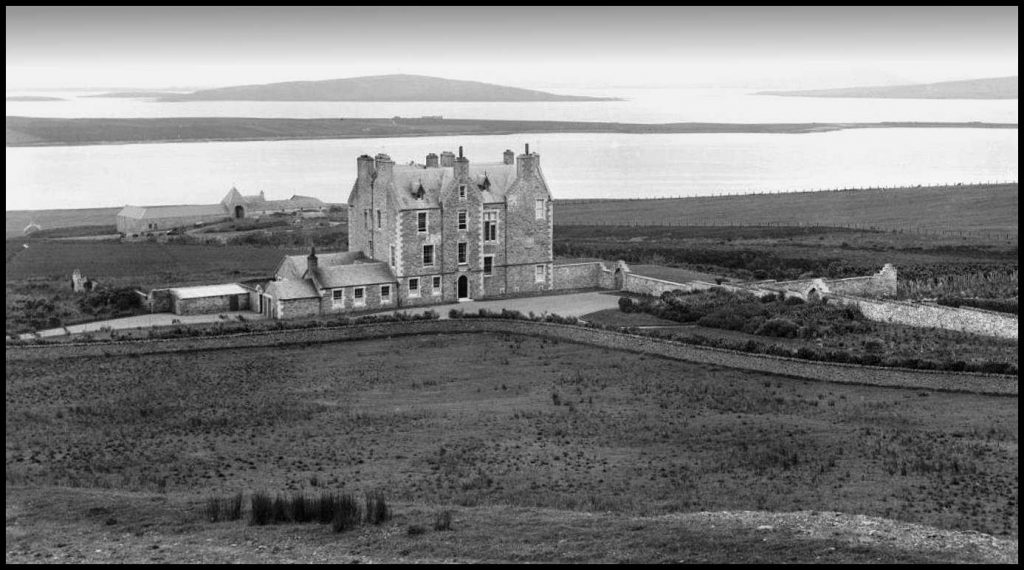
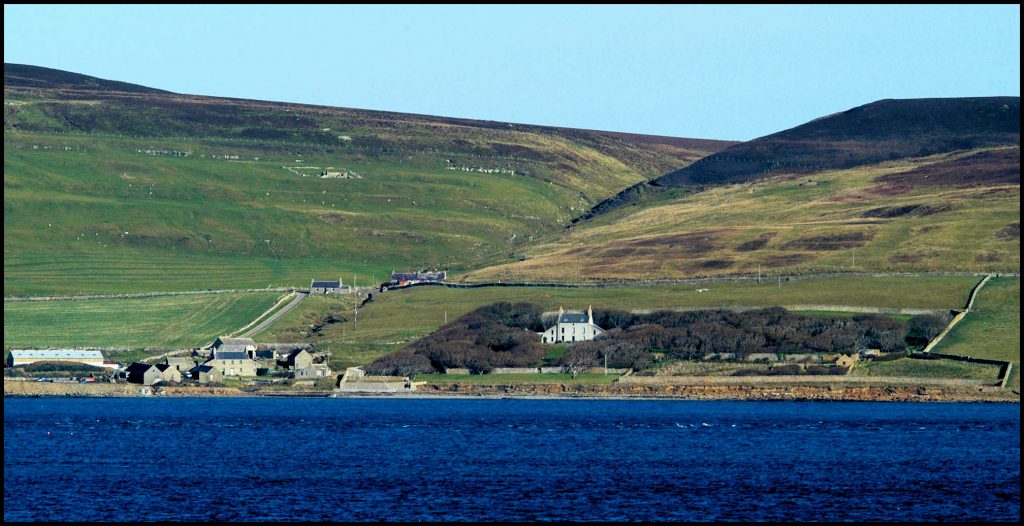
Its replacement, pictured above from Evie, was built in 1792
The Island of Viera – the Vigr of the Norse days – is a peculiarly-shaped island lying on the water about half-a-mile distant from Rousay. It was the place of residence of Holbein Hruga, the collector of the King of Norway’s taxes in Orkney. It is remarkable for the fertility of the soil, and between it and Rousay there is excellent anchorage for vessels in Viera Sound.
The entire estate, including the two islands, extends to about 12,000 acres, of which about 3,148 acres are arable, 3,827 acres moor and pasture, and about 25 acres plantation. The whole of the islands of Rousay and Viera belong to the estate, with the exception of about 250 acres in Rousay, which are held by another proprietor. There is thus a large extent of low-ground and high-ground shooting. The moorland rises immediately behind the mansion, in a series of fine terraces, along which the ground is quite level, and reaches its highest point in Blotchinfield at a height of 811 feet above the sea. From the top of this hill, on a clear day, a magnificent and far-reaching prospect is to be had of sea and land. The moor is well clothed with good heather and grass, and is abundantly watered with springs and rivulets. The ground is so favourable for grouse that no disease has ever occurred on the island. About 300 brace of grouse may be expected over the whole ground at Rousay; but there are none on Viera. Between 400 and 500 brace of grouse have been killed in a season; but the bag is now limited to 300, being 150 brace for Trumland and 150 for Westness. About 200 snipes may be killed, and the rest of the bag should include between 20 and 30 woodcock, the same number of wood-pigeon, 20 wild-duck, 25 or 30 golden plover, 50 brown hares, and 200 rabbits. Wild swans visit the island in winter, and there are numerous seals in summer. There is indeed, plenty of shooting all the year round, and the estate has always been very lightly shot over.
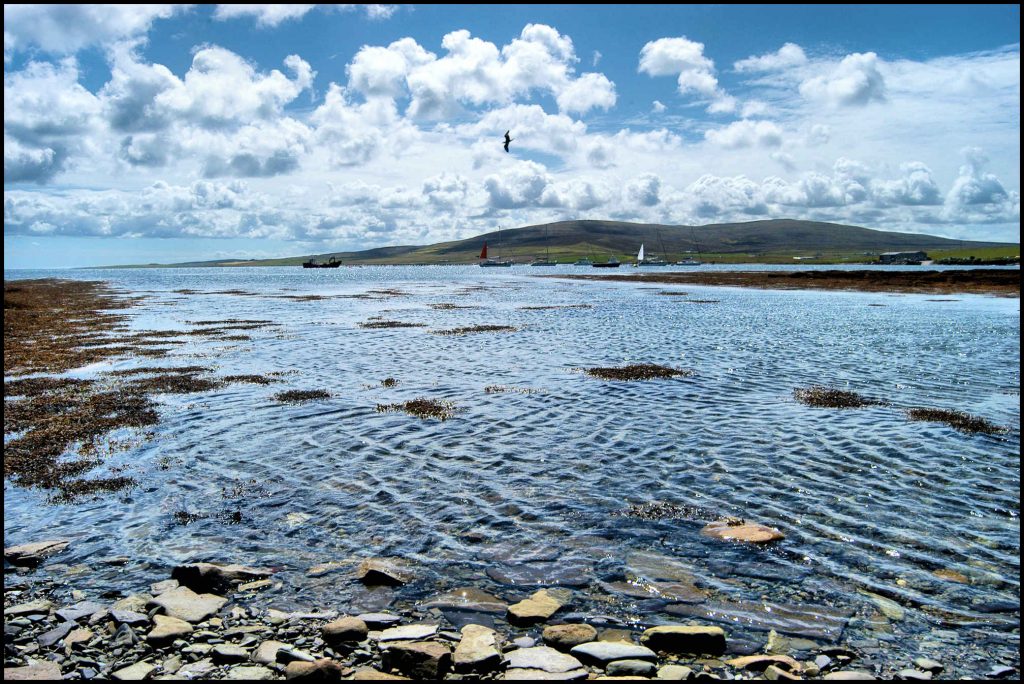
the polar regions’ beached and were killed in August 1861
With the exception of fox-hunting and deer-stalking, the estate gives almost every kind of British sport. In summer there is excellent trout-fishing, yachting, sailing, and rowing among the islands, where there are harbours providing shelter from every wind. There is sea and fresh-water bathing, riding, driving, and picnicking on beautiful spots in all directions, lawn-tennis, &c. Many yachts visit the Orkneys in summer. In autumn there are a variety of winged game shooting; also hares, rabbits, otters, and seal-stalking. In winter there is grouse shooting over dogs until December 10, woodcock shooting, and wild-fowling. In spring, and, in fact, all the year round, there is sea-fishing, which affords great sport. Occasionally there is a whale hunt. In 1875, 100 whales were killed between Rousay and Kirkwall.
The principal fishing lochs are the Muckle Water, Peerie Water, and the Loch of Wasbister or Saviskaill. The Muckle Water is 124 acres in extent, and is connected with Peerie Water, which lies close to it, by a small burn, both locks being connected to the sea by another burn. These lochs are situated amidst the hills of Blotchinfield at a height of over 320 feet above the level of the sea, and are well stocked with trout. There is also a small salt-water loch at Scockness, about four acres in extent, which is most advantageously situated for an oyster farm. There are sea-trout in all the fresh-water lochs; and salmon might easily be introduced into the Loch of Saviskaill or Wasbister, as it is quite close to the sea, and connected to it by a very good burn. About 1,000 trout are usually got in the various waters in the course of a year.
The whole of the island of Rousay is fringed by fine agricultural land, while the island of Viera almost entirely consists of deep rich loam. Aided by the excellent climate, the lands produce first-rate crops, and the rest of the estate is admirably adapted for grazing cattle and sheep. As showing the excellent character of the grazing, it may be mentioned that the stock on the island consists of 172 horses, 798 cattle, and 1,350 sheep; and, as no disease has ever been known to occur on the island, the southern markets have always been open to the raisers of stock in Orkney.
We notice that this fine estate is to be exposed to public sale at the Mart, Tokenhouse Yard, on June 27. It should bring a high price.
==============================================
* General Frederick William Traill-Burroughs of Rousay and Viera had the reputation of being the worst of the 19th century Orkney lairds. He would have left Rousay in 1889 if he had been able to do so, but for a proprietor who was unfortunate enough to be encumbered with a crofting estate, it was not so easy to move as it was for a poor crofter. Because of depressed agricultural conditions, it was difficult to get a good price for an estate, particularly so if the land was held on crofting tenure. Burroughs’ own actions – the publicity there had been about bad landlord-tenant relations – made the sale of Rousay doubly difficult.
Burroughs set about the task of disposing of his estate in a systematic way. First he wrote the article in Rod and Gun, in which he was optimistic to the last. He described the estate as very low-rented and considered that ‘as soon as the agricultural outlook improves, it would admit of a considerable increase.’
He followed his article with a series of advertisements, and although they appeared intermittently over the next few years, he failed to find a buyer. His price was £100,000 but, as Orkney agriculture became increasingly depressed in the 1890s, he was less likely to find anyone willing to offer as much as that. Eventually he resigned himself to remaining on the island.
* Extracted from The Little General and the Rousay Crofters
by
William Paterson Loudoun Thomson
Published in 1981 by John Donald Publishers Ltd, Edinburgh and imprinted by Birlinn Limited, Edinburgh in 2000
